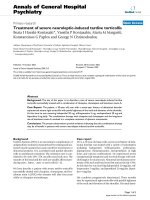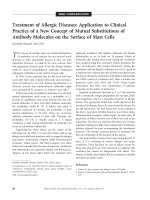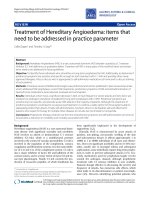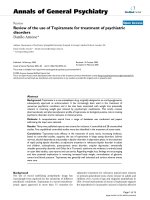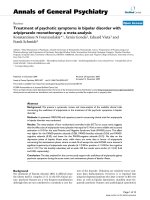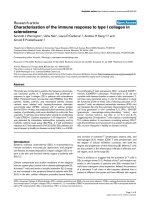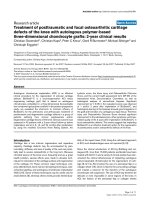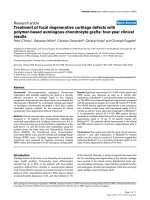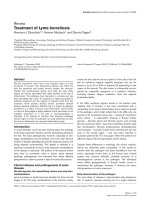Báo cáo y học: " Treatment of stasis dermatitis using aminaphtone: solated angioedema of the bowel due to C1 esterase inhibitor deficiency: a case report and review of literature" pot
Bạn đang xem bản rút gọn của tài liệu. Xem và tải ngay bản đầy đủ của tài liệu tại đây (655.91 KB, 6 trang )
CAS E REP O R T Open Access
Isolated angioedema of the bowel due to C1
esterase inhibitor deficiency: a case report and
review of literature
Shivangi T Kothari
1*
, Anish M Shah
1
, Deviprasad Botu
2
, Robert Spira
1
, Robert Greenblatt
3
and Joseph Depasquale
1
Abstract
Introduction: We report a rare, classic case of isolated angioedema of the bowel due to C1-esterase inhibitor
deficiency. It is a rare presentation and very few cases have been reported worldwide. Angioedema has been
classified into three categories.
Case presentation: A 66-year-old Caucasian man presented with a ten-month history of episodic severe cramping
abdominal pain, associated with loose stools. A colonoscopy performed during an acute attack revealed
nonspecific colitis. Computed tomography of the abdomen performed at the same time showed a thickened small
bowel and ascending colon with a moderate amount of free fluid in the abdomen. Levels of C4 (< 8 mg/dL;
reference range 15 to 50 mg/dL), CH50 (< 10 U/mL; reference range 29 to 45 U/ml) and C1 inhibitor (< 4 mg/dL;
reference range 14 to 30 mg/dL) were all low, supporting a diagnosis of acquired angioedema with isolated bowel
involvement. Our patient’s symptoms improved with antihistamine and supportive treatment.
Conclusion: In addition to a detailed comprehensive medical history, laboratory data and imaging studies are
required to confirm a diagnosis of angioedema due to C1 esterase inhibitor deficiency.
Introduction
The term ‘angioedema’ describes a circumscribed edema
of the skin, gastrointestinal (GI) tract or respiratory
tract . Classic hereditary angioedema (HAE) can be asso-
ciated with quantitative (type I) or qualitative (type II)
deficiency of C1 esterase inhibitor (C1-INH), which is
caused by mutations in the C1-INH gene [1].
In classic HAE, abdominal attacks are mostly charac-
terized by pain, vomiting and diarrhea, but rarely occur
in the absence of other clinical features. These symp-
toms are due to transient edema of the bowel wall,
which can lead to intestinal obstruction, ascites and
hemoconcentration. The diagnosis is based on the his-
tory of attacks and is confirmed by laboratory testing of
C4 levels along with antigenic and functional C1-INH
levels.
We describe a case of isolated angioedema of
the bowel, a rare presentation, occurring in a man with
C1-IN H deficiency [2,3]. We review the various types o f
angioedema, their diagnosis, clinical features and treat-
ment, with emphasis on the GI features and the
management.
Case presentation
A 66-year-old Caucasian man presented with a 10-
month history of episodic severe cramping abdominal
pain, associated with loose stools. Each episode lasted
for a few days and would resolve spontaneously. The
patient’s medical history included renal cell carcinoma
and nephrectomy, transurethral resection of the prostate
for benign prostatic hyperplasia, and hypertension, He
denied any use of non-steroidal anti-inflammatory drugs
or angiotensin-converting enzyme (ACE) inhibitors, any
history of urticaria or laryngeal edema, any drug aller-
gies, or any family history of angioedema. He had not
recently changed his diet or started new medication.
We gave our patient an extensive evalu ation, which
included several esophagogastroduodenoscopies and
colonoscopies over the span of one year, with normal
endoscopic findings. Colonoscopies performed between
* Correspondence:
1
Department of Gastroenterology, School of Health and Medical Sciences
Seton Hall University, South Orange, NJ, USA
Full list of author information is available at the end of the article
Kothari et al. Journal of Medical Case Reports 2011, 5:62
/>JOURNAL OF MEDICAL
CASE REPORTS
© 2011 Kothari et al; licensee BioMed Central Ltd. This is a n Open Access article distributed under the te rms of the Creative Commons
Attribution License ( g/li censes/by/2.0), which permits unrestricted use, distribution, and reproduction in
any medium, provided the original wor k is properly cited.
attacks did not show any evidence of inflammation. His-
tological examination of biopsies did not reveal any aty-
pical cells or expa nded collagen bands. Computed
tomography (CT) of the abdomen performed when the
patient was asymptomatic showed a normal small bowel
(Figure 1). A colonoscopy performed during an acute
attack revealed non-specific colitis, and CT of the abdo-
men performed at the same time showed a thickened
small bowel and ascending colon with a moderate
amount of free fluid in the abdomen. Abdominal arter-
iography showed a patent celiac artery and superior
mesenteric artery (SMA).
The surgical department was consulted and patient
underwent an exploratory laparatomy. An appendect-
omy was performed and a cecal biopsy obtained, which
was normal. However, our patient continued to have
similar attacks.
A small bowel series was performed, and showed muco-
sal irregularities and intramural edema of the distal ileum.
Our patient was hospitalized and treated with intravenous
hydration. He was afebrile at this time. Laboratory investi-
gations revealed that his white blood cell count was 12.7 ×
10
9
/L with 89.4% polymorphonuclear lymphocytes
(reference range 4 to 11 × 10
9
/L and 41.5% to 65%). Hae-
moglobin was 17 g/dL (reference range 13 to 18.0 g/dL)
consistent with hemoconcentration, and the chloride was
low at 99 mmol/L (reference range 95 to 107 mmol/L).
Results of liver function tests and levels of amylase and
lipase were within normal limits.
A repeat inpatient CT scan showed extensive
concentric right and transverse colon thickening, and
concentric thickening of several small bowel loops with
ascites (Figure 2). CT angiography of the abdomen
showed the previous finding of a patent celiac artery
and SMA.
Further laboratory analysis revealed a normal erythro-
cyte sedimentation rate. Stool analysis gave negative
results for Yersinia, ova and parasite, and standard cul-
ture. Levels of prostate specific antigen, carcinoembryo-
nic antigen, anti-neutrophil cytoplasmic antibody, anti-
Saccharomyces cerevisiae antibody, methemoglobin level,
and urine porphobilinogen levels were within normal
limits. Celiac serology testing and testing for anti-
nuclear antibody and carbon monoxide levels were
negative. C3 levels were within normal limits. Levels of
C4 (< 8 mg/dL; reference range 15 to 50 mg/dL), CH50
Figure 1 A-C) Computed tomography scan of abdomen with contrast shows n ormal appearing small bowel and colon during the
asymptomatic phase.
Kothari et al. Journal of Medical Case Reports 2011, 5:62
/>Page 2 of 6
(< 10 U/mL; reference range 29 to 45 U/ml) and C1
inhibitor (< 4 mg/dL; reference range 14 to 30 mg/dL)
were all low, supporting a diagnosis of acquired angioe-
dema (AAE) with isolated bowel involvement. It is pos-
sible, although rare, for a de novo genetic mutation to
lead to angioedema.
Our patient’s symptoms improved with antihistamine
and supportive treatment, w ith danazol treatment
planned on an outpatient basis for prophylaxis after dis-
charge. However, our patient had no recurrences of
similar episodes during follow-up after discharge and we
decided not to start him on any prophylaxis. He has had
no attacks since discharge.
Discussion
Angioedema is characterized by marked swelling, which
can involve the skin, GI t ract and other organs. It has
been classified into three categories (Figure 3, Table 1):
HAE, AAE and idiopathic angioedema (IAE) [4].
HAE was first described by Quincke in 1882 [5]. In
1888, Osler [6] documented its hereditary nature, which
was further defined as autosomal dominant by Crowder
and Crowder in 1917. HAE type I with plasma protein
C1 inhibitor defect was first described by Donaldson in
1963 [6]. The incidence of HAE is estimated at 1 in
50,000. No gender or ethnic group differences have
been noted [ 4]. Symptoms typically worsen after pub-
erty; however, there are reports in the literature o f
patients developing HAE as late as the ninth decade of
life. The severity of the disease usually improves in the
seventh and eighth decades of life [7,8]. A nonhistami-
nergic form of angioedema occurs in about 1 in 20
cases. It is usually not responsive to antihistamines and
not associated with urticaria [3]. HAE is divided into 3
types: (1) HAE-I, caused by a C1-INH gene mutation
resulting in lo w levels or absence of antigenic and func-
tional C1-INH; (2) HAE-II, caused by a C1-I NH gene
mutation resulting in a normal or high C1-INH antigen
level but reduced enzymaticactivityandalowfunc-
tional C1-INH level; (3) estrogen-dependent HAE,
which has normal C1-INH levels and function and nor-
mal genetic analysis, but a direct correlation with estro-
gen levels.
AAE was not identified until 1972 [7]. This form is
usually associated with autoimmune disease, paraneo-
plastic syndromes, medications such as ACE inhibitors
or changes in estrogen levels. There is no familial
inheritance, and it can occur at a later age than HAE.
The condition develops as a result of increased con-
sumption of C1-INH or impairment of C1-INH function
due to autoantibody formation. Acquired angioedema
(AAE) is divided into four groups: (1) AAE-I, resulting
Figure 2 A-C) Computed tomography with contrast shows extensive concentric colonic and small bowel thickening with trace ascites.
Kothari et al. Journal of Medical Case Reports 2011, 5:62
/>Page 3 of 6
from paraneoplastic syndrome or development of auto-
antibodies which enhances cleavage of C1-INH, leading
to C1-INH dysfunction; (2) AAE-II, resulting from auto-
immune disease; (3) AAE associated with sex hormones,
especially in pregnancy; and (4) drug-induced AAE, par-
ticular associated with ACE inhibitors or angiotensin
receptor blockers.
IAE is usually associated with urticaria; thyroid dys-
function is common with t his form and testing should
be performed fo r it. The mechanism of this disease is
unknown.
Angioedema is believed to be due to increased levels
of bradykinin associated with C1-INH deficiency. C1-
INH is a member of the serpin family of serine protease
inhibitors. It is produced mainly in the parenchymal
cells of the liver, and is also found in microglial cells,
fibroblasts and endothelial cells. It controls the four dif-
ferent enzymatic cascades: the complement system, coa-
gulation, fibrinolytic, and kinin system cascades [4,9].
C1-INH inhibits the formation of activated C1 and the
cleavage of C2 and C4. It also inhibits the ability of plas-
min to activate C1 and to generate bradykinin from C2.
Other protease inhibitors such as antithrombin III, b2-
macroglobulin, a1-antitrypsin and a2-antiplasmin also
inhibit the ability of plasmin to generate bradykinin,
suggesting options for potential therapeutic interven-
tions. The classic presentation of angioedema includes
the most common symptom, difficulty in breathing due
to laryngeal edema, along with edema of the skin and
severe episodic abdominal pain.
Two types of abdominal attacks have been described;
the upper GI and the lower GI types. The upper GI
type is extremely painful and associated with nausea,
Figure 3 Diagnostic approach to C1 inhibitor deficiency.
Table 1 Classification of angioedema
Hereditary Acquired Idiopathic
HAE-I AAE-I Nonhistaminergic
HAE-II AAE-II
Estrogen dependent
(HAE-III)
Sex hormone dependent
Drug induced
(ACE-I, ARB)
HAE = hereditary angioedema, AAE = acquired angioedema, ACE =
angiotensin converting enzyme, ARB = angiotensin receptor blocker.
Kothari et al. Journal of Medical Case Reports 2011, 5:62
/>Page 4 of 6
vomiting and hypotension without any diarrhea. The
lower GI type is accompanied by diarrhea without
vomiting [1].
A recent retrospective study involving 153 patients
with HAE reported abdominal pain attacks in five
phases. Phase I starts with a period of non-cramping
abdominal discomfort followed by (phase II) a crescendo
phase which leads to (phase III) severe pain. Phase III is
associate d with vomiting and occasional diarrhea. Hypo-
volemia and hemoconce ntration can occur as a result of
a combination of events including vasodilatation, fluid
shifts with edema of the bowel, ascites, and volume
depletion related to vomiting and diarrhea. Phase IV
refers to a decrescendo phase, which is a self limiting
phase for untreated a bdominal pain. Phase V refers to
the resolution of pain, which can occur as often as twice
a week [1]. Rare symptoms including hemorrhagic
stools, tetany, intussusception and dysuria have been
reported.
The diagnosis of angioedema is made in the context of
the appropriate constellation of medical history and
clinical findings along with supportive laboratory data.
HAE should be suspected when there is a history of
recurrent angioedema without urticaria and an early age
of onset. Symptoms typically worsen over 24 hours and
subside in 48 to 72 hours. Swelling of the upper airways,
skin or GI tract triggered by minor trauma or a stressor,
which fails to respond to treatment with epinephrine,
antihistamines or corticosteroids should also raise the
index of suspicion for angioedema. Patients suspected of
having angioedema should be screened by measuring C4
levels, which are typically low except between the episo-
dic phases. The most sensitive and confirmatory test for
detection of HAE is the measurement of C4d, a cleavage
product of C4, which is abnormal in patients with HAE
even when the C4 level is normal. If the C4 level is
decreased, antigenic and functional levels of C1-INH
should be measured to confirm the diagnosis.
There are several criteria for diagnosis of angioedema.
The major clinical criteria are: (1) self-limiting, recurrent
angioedema without urticaria, lasting for more than 12
hours; (2) recurrent self-limiting abdominal pain, lasting
for more than six hours or (3) recurrent laryngeal
edema. A minor criterion is a family history of recurrent
laryngeal edema, angioedema or abdominal pain.
Laboratory criteria are (1) antigenic C1-INH levels <
50% of normal at two separate determinations with the
patient in basal condition and after the first year of life;
(2) functional C1-INH levels < 50% of normal at two
separate determinations with the patient in basal condi-
tion and after the first year of life; or (3) mutation in
the C1-INH gene altering protein synthesis and or func-
tion. The diagnosis can be made confidently in the pre-
sence of one major clinical and one laboratory criterion.
It is useful to measure C1q level as this is typically
decreased in acquired C1-INH deficiency but normal in
HAE (Figure 3). It is not recommended to measure
complement C3 and CH50 levels, as they are near nor-
mal in angioedema.
Conventional radiographs of abdomen and barium fol-
lowed through during acute attacks depict multiple
dilated small bowel loops with regular thickened muco-
sal folds. A ‘ stacked-coin’ appearance, ‘thumb printing’
and wall thickening may be seen. CT of the abdomen
may reveal bowel thickening and ascites with fluid accu-
mulation in the colon, regardless of the severity of the
attack.
There are three therapeutic goals for patients with
angioedema: immediate treatment, short-term prophy-
laxis and long-term prophylaxis. In acute emergencies
such as laryngeal edema, the immediate treatment is to
maintain an open airway. Abdominal pain secondary to
edema can be controlled with analgesics. Corticosteroids
are of little benefit for patients with angioedema. Short
term prophylaxis involves the withdrawal of precipitat-
ing factors such as oral contraceptives or hormone ther-
apy, as angioedema can w orsen with estrogen therapy.
Attacks have also been associated with stress. The use
of fresh frozen plasma remains controversial as it might
provide factors that could worsen the angioedema.
Replacement of the missing enzyme as C1-INH concen-
trate is the ideal therapy as an immediate, short term or
long term treatment.
Danazol, an attenuated androgen, is used for both
short and long term prophylaxis. For short term prophy-
laxis, (for example, before surgery or dental procedures),
danazol up to 600 mg/day for five days is recommended.
For long term prophylaxis, danazol can be used in doses
ranging from 50 to 600 mg/day according to two differ-
ent protocols. The Milan protocol recommends danazol
at high doses of 400 to 600 mg for four weeks, with the
dosage tapered every four weeks to the minimal effective
dose. The Budapest protocol recommends starting at
lower doses and increasing the dose if needed [4]. In
patients with frequent episodes of angioedema, the
Milan protocol is preferred, and for those with mild epi-
sodes of a ngioedema, the Budapest protocol with a low
dose is recommended.
Other agents used for acute therapy and short and
long term prophylaxis are antifibrinolytic agents such as
tranexamic acid and ε-aminocaproic acid. Tranexamic
acid reduces the frequency of swelling in 70% of
patients. It is used in children with HAE as the first
agent of choice to avoid the virilizing effects of andro-
gens, and is also used in pregnancy. Other potential
agents under study are a human plasma-derived C1-
INH (Berinert P; CSL Behring, Marburg, Germany); ica-
tibant (a specific peptidomimetic bradykinin 2 receptor
Kothari et al. Journal of Medical Case Reports 2011, 5:62
/>Page 5 of 6
antagonist), cinnarizine, plasma kallikrein antagonists,
bradykinin antagonists, serine protease inhibitors and
gene therapy. DX-88 (ecallantide), a 60-amino acid
recombinant protein, which is a sp ecific potent inhibitor
of human plasma kallikrein, has been used successfully
in the treatment of patients experiencing acute HAE
attacks. Cinryze, a plasma derived C1-INH, has been
recently approved by the FDA for prophylactic use for
HAE in the USA. There are isolated case reports sug-
gesting benefit of epinephrine use during acute attack
but the pharmacologic effects of epinephrine do not
explain the pathophysiological perturbations underlying
C1-INH deficiency. A plasma kallikrein 1B antibody
(13G11) helps to detect prekallikreins and hence may be
a helpful test.
There is a 50% risk of a child inheriting the disease
from a parent with angioedema. In the absence of a
genetic diagnosis, it is generally acceptable to wait until
the child is at least one year of age before measuring
the blood for C1-INH defect. As HAE is an autosomal
disorder, when a definitive diagnosis is made, early test-
ing of family members is advisable. Affected individuals
need to be educated about the disease and its inheri-
tance to enable informed decisions about future family
planning.
Close follow-up with appropriate testing is essential
for patients with HAE, and it is advisable for them to
wear a medical alert product.
Conclusion
In summary, the diagnosis of angioedema should be
considered in any patient with recurrent abdominal pain
of obscure origin. There may not be any abnormal find-
ings between attacks, therefore a comprehensive history
and physical examination is of the utmost importance.
Confirmatory laboratory data should be obtained and
imaging studies performed to confirm the diagnosis.
Consent
Written informed consent was obtained from the patient
for publication of this case report and accompanying
images. A copy of the written consent is available for
review by the Editor-in-Chief of this journal.
Author details
1
Department of Gastroenterology, School of Health and Medical Sciences
Seton Hall University, South Orange, NJ, USA.
2
Department of Internal
Medicine, Trinitas Hospital, NJ, USA.
3
Department of Gastroenterology,
Trinitas Hospital, NJ, USA.
Authors’ contributions
STK was the primary author, and contributed to patient’s diagnosis and
treatment in addition to collecting patient information, preparing the
framework of the manuscript, tables, illustrations, and writing the entire case
report with discussion section. AS and DB contributed to the literature
review and data collection. JD worked on the image capturing, legend
writing, reference searching and literature review. RG was the primary
attending physician on this case, and worked on the data collection. RS
worked on the case formatting with grammatical checking and verification
of the discussion section with references. All authors read and approved the
final manuscript.
Competing interests
The authors declare that they have no competing interests.
Received: 25 December 2009 Accepted: 14 February 2011
Published: 14 February 2011
References
1. Bork K, Staubach P, Eckardt AJ, Hardt J: Symptoms, Course, and
Complications of Abdominal Attacks in Hereditary Angioedema due to
C1 Inhibitor Deficiency. Am J Gastroenterol 2006, 101: 619-27.
2. Landerman NS: Hereditary angioneurotic edema. I. Case reports and
review of the literature. J Allergy 1962, 33: 316-29.
3. Cicardi M, Zingale L: Clinical manifestations of HAE. In: Hereditary and
acquired angioedema: Problems and progress. Proceedings of the third
C1 esterase inhibitor deficiency workshop and beyond. J Allergy Clin
Immunol 2004, 114: S55-58.
4. Bowen T, et al: Hereditary angiodema: a current state-of-the-art review,
VII: Canadian Hungarian 2007 International Consensus Algorithm for the
Diagnosis, Therapy, and Management of Hereditary Angioedema. Ann
Allergy Asthma Immunol 2008, 100(Suppl): S30-S40.
5. Quincke H: Concerning the acute localized oedema of the skin. Monatsh
Prakt Derm 1882, 1: 129-131.
6. Osler W: Hereditary angioneurotic edema. Am J Med Sci 1888, 95: 362-367.
7. Caldwell JR, Ruddy S, Schur PH, Austen KF: Acquired C1 inhibitor
deficiency in lymphosarcoma. Clin Immunol Immunopathol 1972, 1: 39-52.
8. Rosen FS, Davis AE Jr: Deficiencies of C1 inhibitor. Best Pract Res Clin
Gastroenterol 2005, 19: 251-261.
9. Donaldson VH, Evans RR: A biochemical abnormality in hereditary
angioneurotic edema: absence of serum inhibitor of C1-esterase. Am J
Med 1963, 35: 37-44.
doi:10.1186/1752-1947-5-62
Cite this article as: Kothari et al.: Isolated angioedema of the bowel due
to C1 esterase inhibitor deficiency: a case report and review of
literature. Journal of Medical Case Reports 2011 5:62.
Submit your next manuscript to BioMed Central
and take full advantage of:
• Convenient online submission
• Thorough peer review
• No space constraints or color figure charges
• Immediate publication on acceptance
• Inclusion in PubMed, CAS, Scopus and Google Scholar
• Research which is freely available for redistribution
Submit your manuscript at
www.biomedcentral.com/submit
Kothari et al. Journal of Medical Case Reports 2011, 5:62
/>Page 6 of 6
